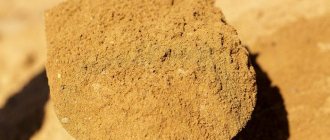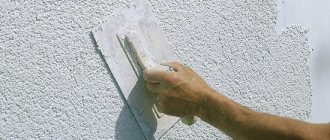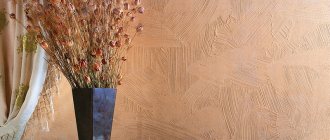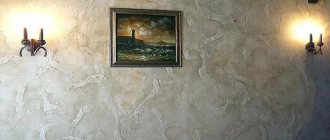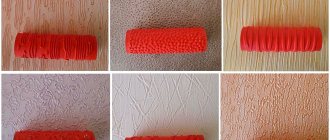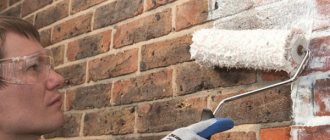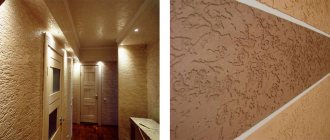In order to protect decorative plaster, experts in the construction field advise using varnish. It not only reliably protects the coating from gradual fading and various damage, but also makes its appearance even more attractive. Therefore, it is necessary to clearly understand the main features of the materials used.
Why do you need to varnish plaster?
If you do not protect the plaster in time by applying a surface layer, then it will gradually acquire a porous and rough structure, absorb moisture and odors from the outside, and will not concentrate light rays on itself. The plaster will very quickly become covered with drips and small scratches, and its delicate relief will begin to chip.
But, if you immediately coat the surface with high-quality varnish, a transparent layer will protect it from damage. It will not allow various external influences to affect the plaster. In addition, varnishing will give it a spectacular mirror or matte shine.
The plaster solution contains special inclusions that enhance the resistance of the future coating from intense ultraviolet radiation. The varnish will also make it more durable. The surface will remain bright longer, its color will acquire a rich shade.
In addition, the varnish has disinfecting properties and becomes a barrier against fungi, pathogenic microorganisms and mold.
Choosing the optimal composition
First of all, it is necessary to consider the compatibility of the plaster varnish with the surface on which it will be applied.
In this case, it is recommended to use only certified compounds intended for this type of work.
To make your choice easier, you can use the table below as a guide.
Water-soluble varnish is quite suitable for interior decoration.
In addition, one must take into account its aesthetic properties in combination with the interior that the surface will have to accept. For example, for application to a wall indoors, it is recommended to use a solution that is safe in its chemical composition.
One of the most common and affordable in terms of price characteristics is water-soluble varnish. Treatment of street walls is carried out with a composition containing an organic solvent, which is more resistant to atmospheric influences.
In addition, classification occurs not only according to the chemical and organic composition, but also according to the degree of dullness, purpose, decorative features, and drying time. Today, the construction market offers a wide selection of different compositions, which can be applied to any surface. But, as mentioned earlier, to maintain breathability and moisture resistance, it is best to use varnishes designed specifically for working with textured plaster. For more information on how to apply varnish to plaster, watch this useful video:
Using plaster varnish you can get a glossy surface without much effort. At the same time, she will not need periodic care for a long time.
Acrylic water based
It is considered the most optimal option for indoor use. Has no pungent odor, non-toxic, environmentally friendly.
In addition, the acrylic composition interacts well with the material of the wall surface, is easy to paint, while maintaining the texture. Designed to increase the gloss effect, it can be tinted well both pigmentally and specifically.
Despite its milky tint when applied, after the surface dries, a protective layer is formed on it that does not distort the main color.
In addition, water-based acrylic varnish has several more distinctive characteristics that are unusual for other compositions:
- Well put together.
- Possesses high-quality adhesion.
- Resistant to sunlight, moisture, and chemical cleaning agents.
- Does not contain organic solvents.
- If necessary, it can be diluted with plain water.
- At room temperature it dries within 3 – 4 hours.
- Used for walls made of various materials.
Polyurethane
Polyurethane varnishes are very durable
Water-based varnish with the addition of polyurethane is mainly used for application to wooden or mineral walls. However, on decorative plaster it does not lose its properties and serves while maintaining all its useful characteristics.
It is characterized by high strength, moisture resistance, and has excellent physical and mechanical properties. The absence of solvent in its composition guarantees good environmental friendliness and the possibility of using it indoors.
Regardless of the chosen varnish, when applying it is necessary to strictly follow the rules for varnishing textured surfaces. This will allow you to achieve the best result even without resorting to the services of specialists.
Competent and correct processing will allow you to forget about repairing or replacing damaged areas for a long time.
Decorative plaster serves as an excellent alternative to traditional wallpaper. Initially, it has a white or gray color, which allows homeowners to show their imagination and create an interior in an original style using paint.
Advantages, disadvantages and useful properties
The main advantage of varnish coating is that it makes the plaster more durable.
Applying a top layer protects it from negative influences and prevents gradual abrasion. The great advantage of varnish is that it makes the surface insensitive to mechanical damage and does not allow it to fade.
Modern compositions have hypoallergenic properties, they are harmless to people and completely environmentally friendly.
Plaster varnish does not interfere with periodic cleaning of walls or ceilings. It remains attractive for quite a long time and does not require additional updating or repairs.
It is easy to apply this material on both flat and embossed substrates. It’s just as easy to clean it from it. You can cover the surface with metal dust, mother of pearl or tinting.
The disadvantage of varnish coating is that the cost of repair work increases. In addition, in the case of additional finishing, a new layer has to be applied, which will stand out against the general background.
The beneficial properties of varnishing are that the ceiling and walls can be washed or brushed.
Advantages and disadvantages of coating liquid wallpaper with varnish
Liquid wallpaper coated with varnish has its positive and negative aspects. Among the advantages of using protective material, the following are worth noting:
- The material has a water-repellent effect, which is especially important when used inside the bathroom and rooms with high humidity.
- Thanks to the varnish coating, additional protection of the walls is formed and the service life is increased.
- The varnish layer scatters the sun's rays, which prevents the paint from fading on the surface.
- Thanks to the antistatic effect, the walls become less susceptible to various contaminations.
After the varnish has dried, the color of the liquid wallpaper will be a tone darker.
The disadvantages of the varnish layer include:
- Application increases the textured volume of the walls, while reducing the visual space of the room.
- If the need arises for repairs, liquid wallpaper with a varnish coating will be more difficult to remove from the surface.
- When using additional materials, the cost of repairs will be much higher compared to the usual finishing option.
If you want to increase the strength of the decorative layer, it is worth performing additional treatment of the material with varnish, but you must take into account the possible inconvenience and cost of finishing.
What is the best varnish to coat decorative plaster?
In order to choose the optimal type of material, you need to know its main features. Different types of varnishes differ in purpose, characteristics and the resulting aesthetic result.
Any varnish for decorative plaster is suitable for finishing.
But when renovating a residential premises, you need to avoid those materials that will be potentially dangerous to people during the work being carried out or subsequent absorption of moisture. Therefore, various features of the main types of compositions should be taken into account.
Acrylic varnish for coating
This type of material is created based on an aqueous dispersion of acrylic resins. It is a saturated white liquid. An opaque homogeneous solution is mixed with stabilizing additives.
For interior finishing work, water-based acrylic varnish for decorative plaster is best suited. It is odorless and does not have allergenic properties.
When applied to plaster, the coating dries very quickly. The result is a durable film that retains its original color. It interacts well with the main surface material and is easy to paint while maintaining the overall texture. The varnished surface has a beautiful glossy shine.
At normal temperature and humidity, the coating dries within 3 hours.
Main advantages of acrylic:
- long service life;
- exceptionally advantageous appearance;
- easy coloring;
- complete absence of yellowing over time;
- ease of application;
- strength, etc.
When choosing which varnish to coat decorative plaster with, you need to take into account that to achieve the best result, it is advisable to allocate at least 14 days. Only after this period is it possible to identify all the shortcomings and correct them in a timely manner.
Polyurethane varnish
The material is created on the basis of aliphatic hydrocarbons, alkyd-urethane resins and special additives. It is produced on a water basis, therefore it is harmless to humans.
Polyurethane coating is best suited for interior spaces. It works best on wooden surfaces, but is also suitable for plaster.
The varnish is very durable and has reliable environmental resistance characteristics. There is no solvent in its composition, so the material does not have a negative effect on the human respiratory system. But when using it, it is necessary to comply with all safety conditions, just as when working with other types of materials.
The coating dries extremely quickly, creating a durable, highly elastic film.
Other advantages of polyurethane over other types of materials are:
- ease of cleaning;
- reliability;
- the most favorable shade;
- increased moisture resistance;
- pleasant shine;
- good adhesive properties, etc.
The main disadvantage of polyurethane varnish is that it cannot be cleaned with alcohol solutions. Moreover, it is expensive.
Facade materials
If you have to finish external coatings, then water-based compounds will not be suitable here.
For facades, products based on organic solvents are used.
These include:
- alkyd mixtures;
- nitro and oil varnishes;
- silicone materials;
- urethane mixtures;
- epoxy compounds;
- shellacs.
All materials are characterized by increased resistance to environmental influences.
There are also glossy compounds that have a durable moisture-proof layer and do not allow various external contaminants to settle on the plaster.
Matt varnish is mainly intended for covering Venetian plaster. It allows you to preserve the relief finishing material without losing its aesthetic qualities.
Gold and silver coatings allow you to create bright accents while highlighting a number of details.
The craquelure composition creates the effect of antiquity with the highlighting of decorative cracks.
Mother-of-pearl materials shimmer spectacularly. Therefore, they are most often used to make the marble tone look more embossed.
Special decorative materials
Construction stores sell ready-made mixtures that allow you to create various coatings for plaster.
The most commonly used is craquelure varnish. It is suitable for creating an antique effect and highlighting artificial cracks on the surfaces of ceilings and walls.
A composition with a holographic effect gives the plaster a special beauty, attractiveness and modernity.
Silver and gold materials are often used, giving the coating a specific shade. The mother-of-pearl mixture creates a spectacular pearl shimmer on the plaster.
Why do you need surface varnishing?
First, you just need to figure out what varnish for decorative plaster is used for, and whether it is possible to do without this procedure at all.
Experts say that today there are many materials for interior and exterior decoration on sale. One of them is varnishing. This process is needed for several reasons:
- The materials that act as the base are well strengthened.
- The finish is protected from moisture, which can penetrate the product and harm it.
- Wax and varnish for decorative plaster prevent the penetration of chemicals and other substances into the interior and various mechanical damage.
- Mold will not be able to penetrate the finish or develop inside this material.
- The varnish can very well retain its original shape, so the facade will be durable and beautiful for a long time. Manufacturers guarantee the preservation of colors and their saturation.
Thanks to varnishing, the surface may not be washed off during repeated cleaning. On the contrary, it becomes brighter and more attractive.
Recipe for making varnish for decorative plaster with your own hands
The most commonly used factory composition is water-based, which is brought to the desired state on its own.
Glazing varnish is often subjected to similar preparation. You should take 60 g of water-soluble acrylic mixture per 2 liters of water. Then add 1 g of glitter into it and mix the solution thoroughly.
When creating a shimmering effect, take 1 tsp. glitter per 1 liter of glaze composition.
Sometimes it is necessary to eliminate excessive glossy shine in the decoration of residential premises. Then you need to take the varnish composition and dilute it by half or a third with water.
For stronger adhesion to the surface, you need to take wallpaper glue (2 parts). After dilution with water, the composition is mixed with an acrylic base (1 part). Then it is painted in the chosen shade and brought to the thickness that the putty has. The coating is applied with a rubber spatula to the decorative plaster. The resulting layer is lightly pressed down to fill the indentations.
As an example, it’s worth creating a homemade two-ton varnish for bark beetle plaster. The moves are filled with a darker color, and the main background is made light.
In practice, this work looks like this: The entire surface of the ceiling or wall is made light. Then dark azure is prepared. Using a rubber spatula, the material is carefully applied to the strip. Then the upper part of the relief will look lighter than the recesses.
DIY wax recipe
High-quality products are quite expensive, and it is not always possible to decorate the entire room with them. In this case, there is the option of making your own composition for finishing the plaster.
Soap based wax
This product is prepared from ordinary toilet soap. A 150 g piece is planed on a grater with large holes, then poured with 7 liters of boiling water and brought until completely dissolved. Separately, dilute 2 teaspoons of soda in a small amount of water and add to the soap solution. Whisk the mixture and leave until it cools. Afterwards the wax is ready for application.
The wax composition can be prepared from soap and soda
Composition based on natural wax
You need to prepare the following ingredients:
- 2 parts beeswax (can be replaced with paraffin),
- 1 part purified turpentine,
- 1 part flaxseed oil,
- any pigments (if needed).
The wax is cut and melted in a water bath. Add the remaining components, use a whisk to make the mixture homogeneous, allow to cool and use as intended.
Beeswax for preparing a natural protective composition
Wax based wallpaper glue
Wallpaper glue is diluted in advance according to the instructions. Leave it for half an hour, strain to eliminate the presence of lumps. Add 1 part acrylic varnish and ½ part any decorative paint to 2 parts glue. Mix the composition well and apply it to the plaster like regular wax. If the finish is planned to be colorless, paint may not be added.
How to prepare the surface for glazing compounds
Before glazing begins, the plaster must dry. Then it is thoroughly wiped and cleaned. There is no need to prime it. But to reduce unnecessary waste of expensive materials and improve adhesion to the surface, it is better to cover the outer layer of primer with plaster. If the material has already been varnished, then the old coating is removed with solvent compounds.
Alkyd or waterborne paint is removed and then sanded over the surface to improve the adhesive properties of the surface. Then they clean it thoroughly again.
How to choose a varnish
For interior work, you should select safe water-based varnish mixtures. If the finishing is done outside, then such products must contain organic solvents and be resistant to environmental influences.
When choosing a varnish, it is necessary to take into account the desired aesthetic qualities of the treated surface. In addition to solvent components, all varnish mixtures are classified according to:
- constituent substances;
- purpose;
- dullness level;
- setting period with the base.
To finish textured plaster, you can use any varnish, but it is better to use special ones (originally intended for decorating plaster bases). They will not allow the characteristics of the base materials to deteriorate in terms of breathability and moisture resistance.
Glazing tool
The following most popular types of construction tools are used:
- rollers with rounded edges for applying acrylic;
- rags;
- foam sponge;
- spray gun;
- paint brush (preferably several);
- masking tape to protect adjacent structures and surface areas from varnish and other materials.
After finishing work, the tools need to be thoroughly cleaned and rinsed. Otherwise, it will harden and will be unsuitable for further use.
Is it possible to varnish liquid wallpaper and why?
Professionals say that when performing work, varnish for liquid wallpaper can be used, this is one of the conditions for improving the properties of the material. This coating was developed specifically as a finishing treatment for walls when performing repair and finishing work.
Varnish is most often applied to liquid wallpaper to achieve the following effects:
- A layer of varnish allows you to effortlessly remove any dirt on the wall.
- To increase the hydrophobic effect of the treated wall.
- In order to increase the strength of decorative coating factors and reduce the influence of damaging factors.
Typically, wallpaper is varnished in rooms such as the kitchen or bathroom, since these rooms have increased humidity and the risk of contamination.
Application technology
Varnish compositions should be applied taking into account all the requirements for their operation, otherwise the surface of the plaster will be hopelessly damaged. Instructions are always included with the package.
First, wash it well.
The following must be removed from the floor or wall:
- dirt;
- crumbling and damaged areas;
- dust;
- spots;
- washouts;
- old finishing, etc.
Then the surface must be thoroughly primed. Then the top layer of varnish will lay down easily and securely. The primer must have the same properties as the material being applied. That is, for example, if acrylic is used, then the primer must be appropriate.
Then the mixture is adjusted to the required thickness with water or a solvent, following the instructions included with the composition. Dilute the varnish in a ratio of 1:10, stirring thoroughly until homogeneous. If desired, coloring compounds are also added here.
Then the material is evenly applied to the surface with a spray bottle. To create a decorative effect, it is better to use a roller, sponge or brush.
The most profitable option is considered to be varnishing all 3 layers of plaster. Before applying the next coating, you must wait until the previous one has completely dried. The corners are retouched with a thin brush.
The varnish is applied in one step without interruption, otherwise the joints will be visible to the naked eye. Therefore, large areas are covered by several people. One is better off using a spray gun.
If you don’t have one, then you should stock up on a foam roller with rounded edges. The composition is applied in multidirectional movements. If a sponge is used, the movements should be circular. Such a tool will give the coating a decorative effect.
The varnish is applied to the plaster in a thin layer. The container with it needs to be shaken periodically to avoid gradual hardening. If thickening has occurred, the composition is diluted with water according to the instructions supplied with it.
It is also necessary to take into account the air temperature. For acrylic, the range is +10...+35°C with a humidity of 80%. For polyurethane, a range of +18...+25°C with a humidity of 55-60% is suitable. The varnish composition itself must correspond to a temperature not lower than +13°C.
Goggles, gloves and a respirator must be used to protect eyes, respiratory tract and skin.
Application
Work with varnish begins at the final stages of finishing. But before you start covering the walls, you need to properly prepare the base. This work may take quite a lot of time.
You need to prime the base first. This will give the required tenacity to the connection of the varnish with the wall material. Then you can apply the solution. Each of these actions requires a certain amount of time for the layers to dry. If the treatment is carried out in two layers, it is necessary to color the walls.
Coating: varnish
If the varnish mixture is created on an organic basis, then it is not suitable for finishing the facade. Please note that applying varnish is the final stage of any repair work.
Each material is designed to create a selected color effect. To color the coating, slowly add the color pigment into the container, stirring it constantly. The dye should completely dissolve. To achieve the required shade, first test on a small area.
To create pearlescent varnish, professionalism is required. When adding glitter or metal dust, it is enough to simply homogenize the compositions. For those who have not yet acquired the necessary skill, it is better to use water-dispersed materials. They dry faster and are easier to apply.
They are prepared in the required volume to decorate the entire surface at once. The color will be more saturated when applied thickly and creates a thick coating. If you do not use shading, the joints of adjacent strips will be visible when drying.
How to tint varnish
If you can’t choose a color from ready-made compounds, you can purchase a colorless one and get the desired shade yourself. To give the desired color, special solutions are used - tints. Additionally, you will need scales, a mixing container and a drill with a mixer attachment.
- Pour the required amount of varnish into a container and weigh it.
- The maximum allowable amount of color is 10% of the base. It is advisable not to pour out all the paste at once, but add in small portions and then stir.
- Then apply the liquid to a sample of the coating and wait until it dries to evaluate the result.
It is important to remember that acrylic compositions may darken slightly after drying.
Advantages over wax
No less often, wax is used to coat plaster. For Venetian plaster, a dense layer of material is applied. A special decorative composition is used. The process of applying it is similar to varnishing.
Although wax has been used for a long time, varnish has now become much more in demand.
It has a number of special advantages, including the following:
- The varnish is very durable.
- If a beginner is doing plastering work, then the adjacent stripes of varnish are not as noticeable as wax stripes.
- The varnish composition does not leave stains or streaks. It's easier to apply.
- After applying the wax coating, special treatment is required.
- The only way to remove wax is by sanding. The textured area is difficult to clean and is unlikely to be painted again due to reduced adhesion. In addition, the plaster will be damaged. The varnish is removed with a solvent. It will last longer, but you will have to pay a much higher price for its purchase and repair work.
Wax reviews
According to the masters, the advantages of wax are difficult to overestimate. After waxing, the surfaces look expensive and elegant. With the right color selection, the room will be even more stylish and attractive. In reviews, users note that after applying wax, walls do not deteriorate from water or constantly high air humidity. Housewives like that it is easy to care for such surfaces - they can simply be washed with a cloth.
Having chosen decorative plaster for finishing your house, you should immediately think about protecting it and applying the finishing coat. Ideally, it would be wax: this material is very beautiful, reliable and lasts for many years!
Care of the treated surface
There is a whole industry of care products for varnished surfaces.
Removers are used to remove severe contamination. Varnished coatings collect a lot of dust. Therefore, it is recommended to use a vacuum cleaner to clean them. Surfaces should be cleaned regularly with a sponge, detergent and special solutions. It is advisable to treat them with clinker concentrators at least 2 times a week. Once every 6 months it is necessary to use polyurethane reducing agents. When renewing the varnish layer, you need to use a polish every 4 months.
Why varnish
Typically, the plaster layer is varnished to achieve the following goals:
- strengthen the base material;
- protect the surface from the negative influence of external factors: mechanical damage, moisture, chemical compounds;
- prevent the development of fungus and mold;
- create a base suitable for wet cleaning;
- extend the service life of decorative finishes.
The final varnish layer applied to textured plaster perfectly complements the interior and enhances the decorative effect of the surface.
Many other materials (such as wax) can also be used to achieve the above results, but varnish is considered the most popular method. All this thanks to its multiple advantages:
- easy to apply;
- gives the surface originality;
- creates a durable protective layer;
- easy to remove (using a special solvent);
- does not leave streaks or stains.
As practice shows, the varnish composition in its properties is in many ways superior to other paints and varnishes, which are often used to cover pre-plastered substrates.
A varnish coating on the walls will decorate any room and make its interior more luxurious Source vid-stroy.ru
Removing varnish from the surface and correcting application errors
If some flaws are identified, you should wait 3 days for the deep areas of the varnish and the surface of the film to dry completely.
Small drips are carefully cut off using a chisel with the bevel facing up. Then the surface is allowed to dry for 1 or 2 days. Then the coating is sanded with No. 320 sandpaper, and then varnished again.
If gaps are found, the surface around them is ground, leaving a bad area. Afterwards, varnish is applied to it, making the layers at the edges thinner. Every other day, a layer of glazing material is created. When the surface hardens slightly, the unfinished area is dissolved with a special compound and glazed again.
Varnishing decorative plaster requires skill. If you have not purchased them yet, you must strictly follow the instructions. Only then will it be possible to achieve excellent results.
Instructions for applying varnish
Coating walls is quite simple, but to achieve the desired result, a number of conditions and rules must be observed.
For application, you can use step-by-step instructions:
- Initially, you should prepare a varnish solution; for this, the mixture is diluted in accordance with the instructions indicated on the manufacturer’s packaging.
- It is necessary to wait until the surface is dry, since liquid mortar cannot be processed on the wall. The wallpaper dries completely in 1-2 days, after which finishing is carried out.
- There may be different options for the coating used, but it is best to use an acrylic version for the coating.
- The varnish layer must be applied evenly; for this you can use various improvised tools or mechanical spraying devices.
- The procedure must be repeated several times; 2-3 layers of coating should remain on the wall. All you have to do is wait for the solution to dry.
Using plaster
Decorative gypsum stone is produced by many manufacturing plants; it can even be created at home using dry powder. An aqueous gypsum mixture is prepared, which is poured into molds in which it hardens. The result is attractive figures, tiles, or other products that can be used to decorate rooms. They can be given any color you want by adding the necessary paint or pigment. To enhance the strength of a gypsum product, special modifiers and sand are added.
Gypsum stone has a beautiful shape, it is very similar to artificial tiles or bricks, and looks very beautiful when facing doorways and walls. In addition, it can be used in combination with plaster, tiles, wood, photo wallpaper and regular wallpaper. Gypsum stones are used either as fragmentary or complete finishing of premises. The stone is used for cladding fireplaces and emphasizing the bases of columns. Gypsum stucco is sold in any hardware store, and moldings made from this material are also sold, used to decorate ceilings and walls. From gypsum powder you can create very beautiful figurines, figurines for the garden, and all kinds of sculptures.
Varieties
When choosing a varnish composition for plaster, it is worth studying the main characteristics of the most popular types of such a product. There are quite a lot of them on the construction market today.
Acrylic
It is considered one of the best options for interior wall decoration. It fits perfectly on a textured surface and gives it a beautiful gloss. This varnish product is a milky liquid in color. After drying, it forms a protective film that does not at all affect the main shade of the wall. At normal temperatures, the created coating dries in only three hours. If necessary, the composition can be diluted with water, but the applied layer will subsequently become thinner.
Acrylic varnish is a mixture of high-quality aqueous dispersions of acrylic resins with the addition of enhancing substances Source vinnica.prom.ua
Among the advantages of acrylic varnish it is worth highlighting the following:
- no odors;
- safety;
- resistance to moisture, ultraviolet radiation;
- has good adhesion;
- diluted with ordinary water;
- not afraid of cleaning chemicals;
- sets quickly;
- can be used for rooms for different purposes.
Craftsmen often add pearlescent pigments to the acrylic composition, giving the plastered surface shine and an attractive shimmer.
Acrylic varnish with pearlescent pigments gives the treated surface an extremely attractive shimmer Source i2.wp.com
